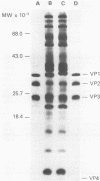Abstract
Serial "blind" passages in human rhabdomyosarcoma (RD) cells of prototype viruses from each of the six immunotypes of the group B coxsackieviruses (CB) resulted in the isolation of intratypic variants of CB1, CB3, CB5, and CB6. Each variant virus strain acquired the capacity to agglutinate human erythrocytes and produce small plaques on HeLa cells, although their serological specificity remained unchanged. An alteration in VP1 mobility in sodium dodecyl sulfate-polyacrylamide gel electrophoresis was noted for CB3-RD. The CB3-RD variant was plaque purified on RD cells and studied for receptor interactions on both HeLa and RD cells. An attachment restriction appeared to exist for prototype CB3 on RD cells, whereas CB3-RD attached well to both cells. In attachment interference assays, HeLa cells saturated with CB3-RD blocked the attachment of CB3. In contrast, saturation of cells with CB1 (which shares a common receptor with parental CB3) failed to block the attachment of CB3-RD. This unidirectional receptor blockade suggested that a second site for the attachment of virions to receptors was acquired by the CB3-RD variant. Thus, more than one virus receptor specificity may be operative in the selection of host range virus mutants. The implications of this phenomenon as they may relate to pathogenesis are discussed.
Full text
PDF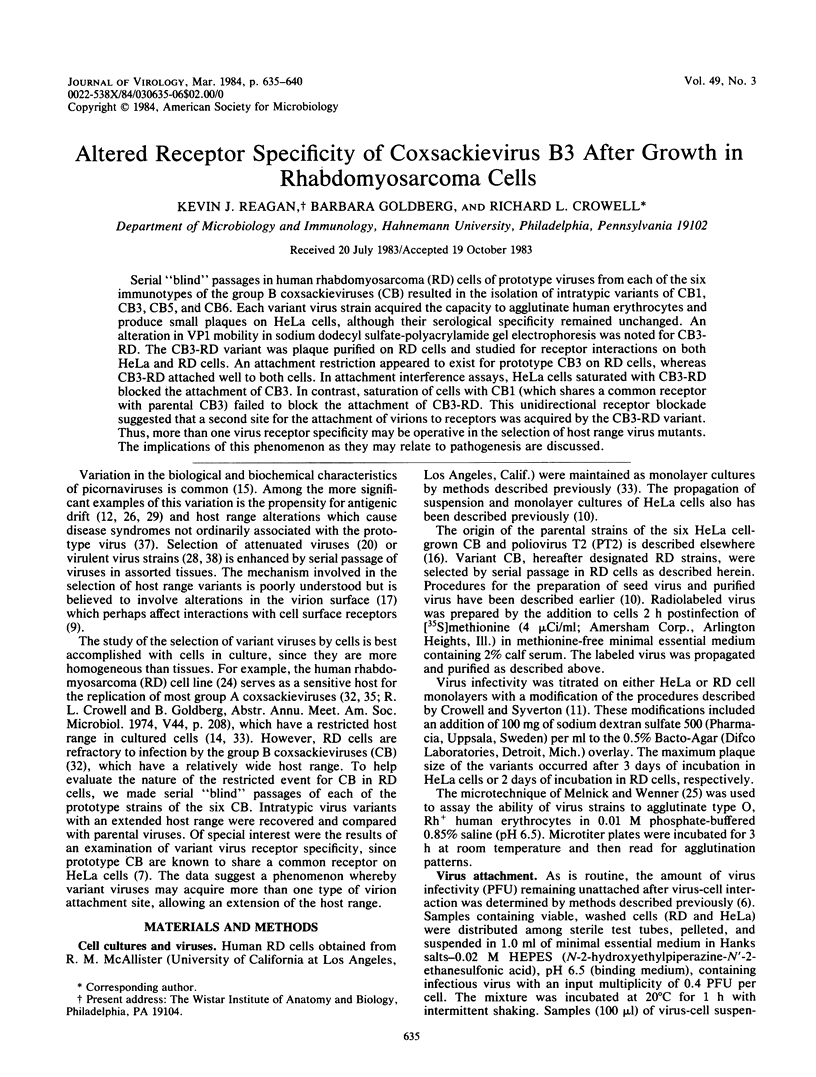
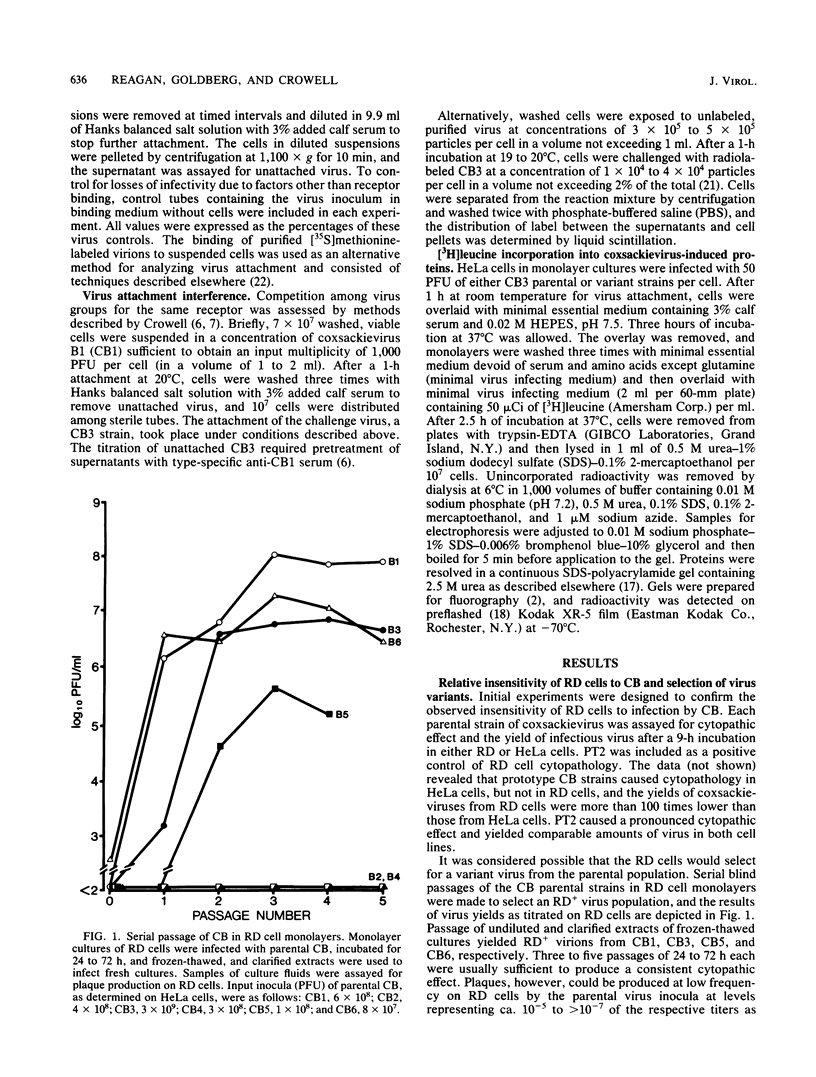
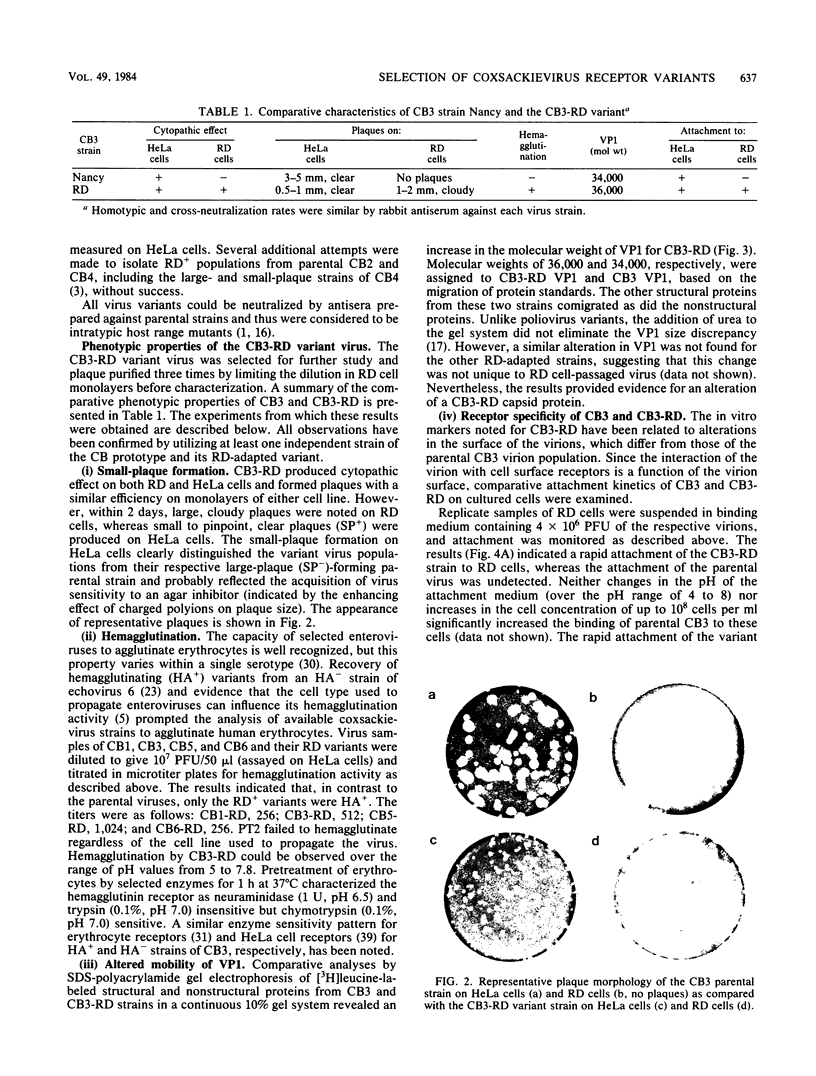
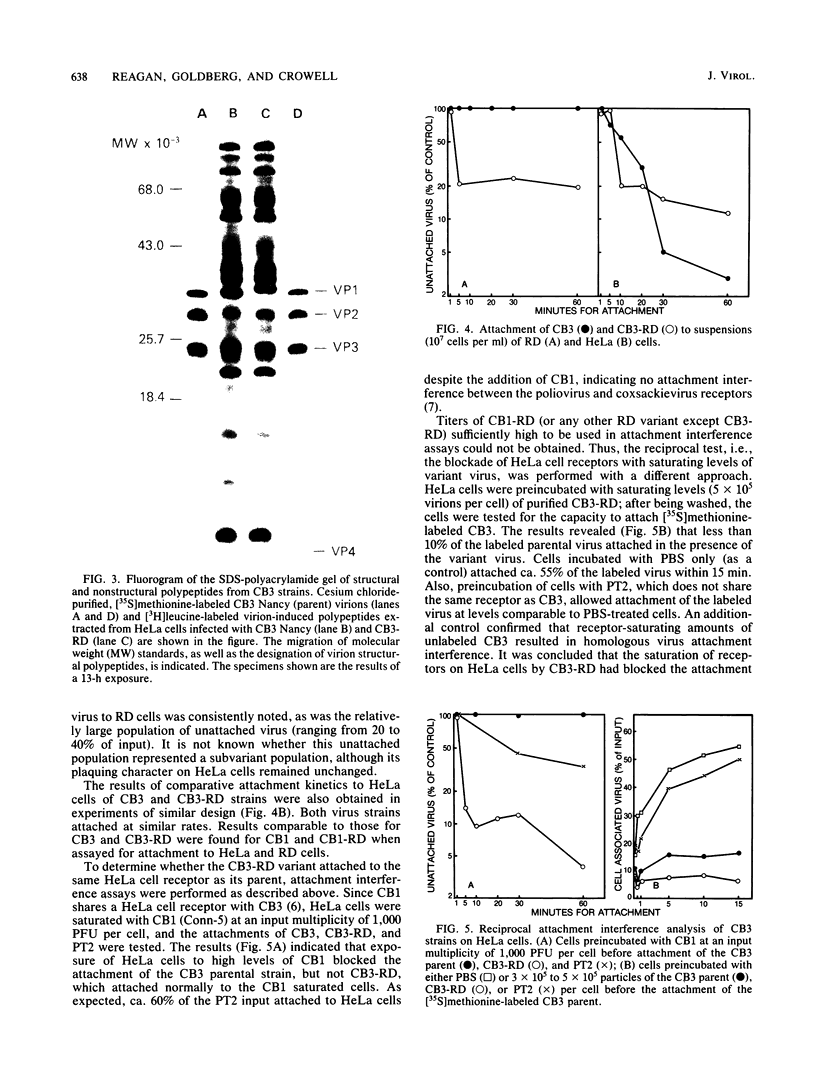
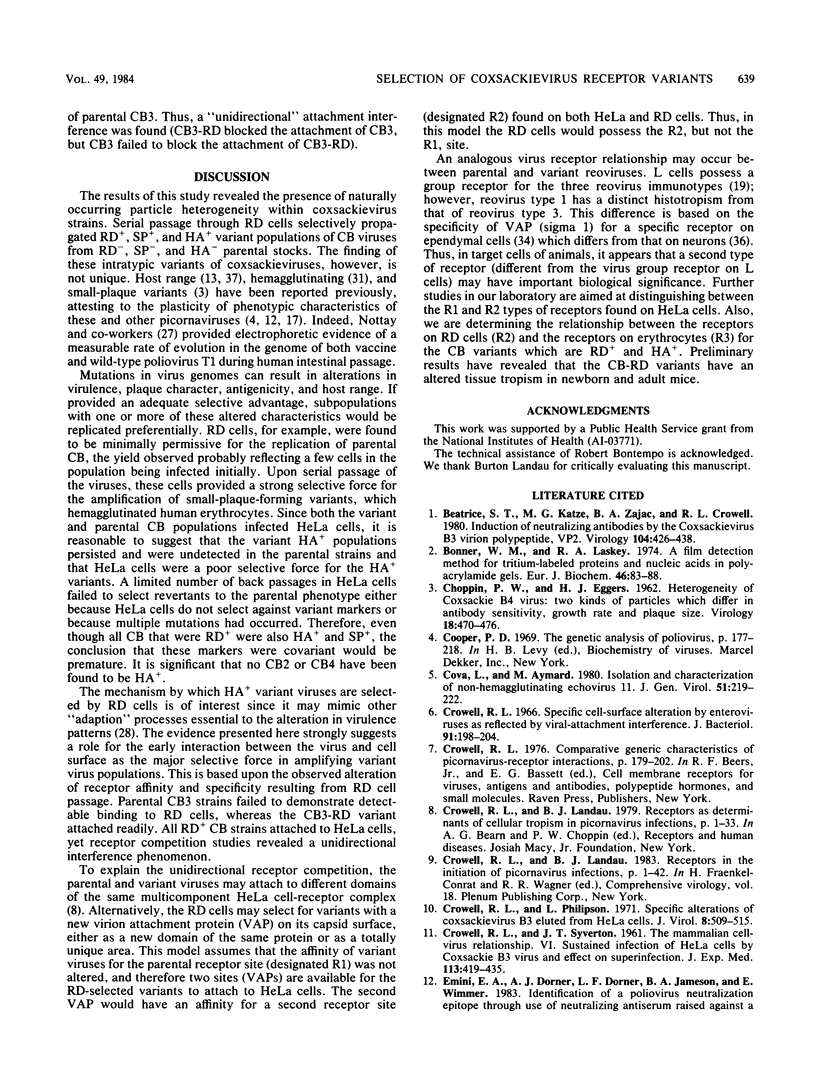
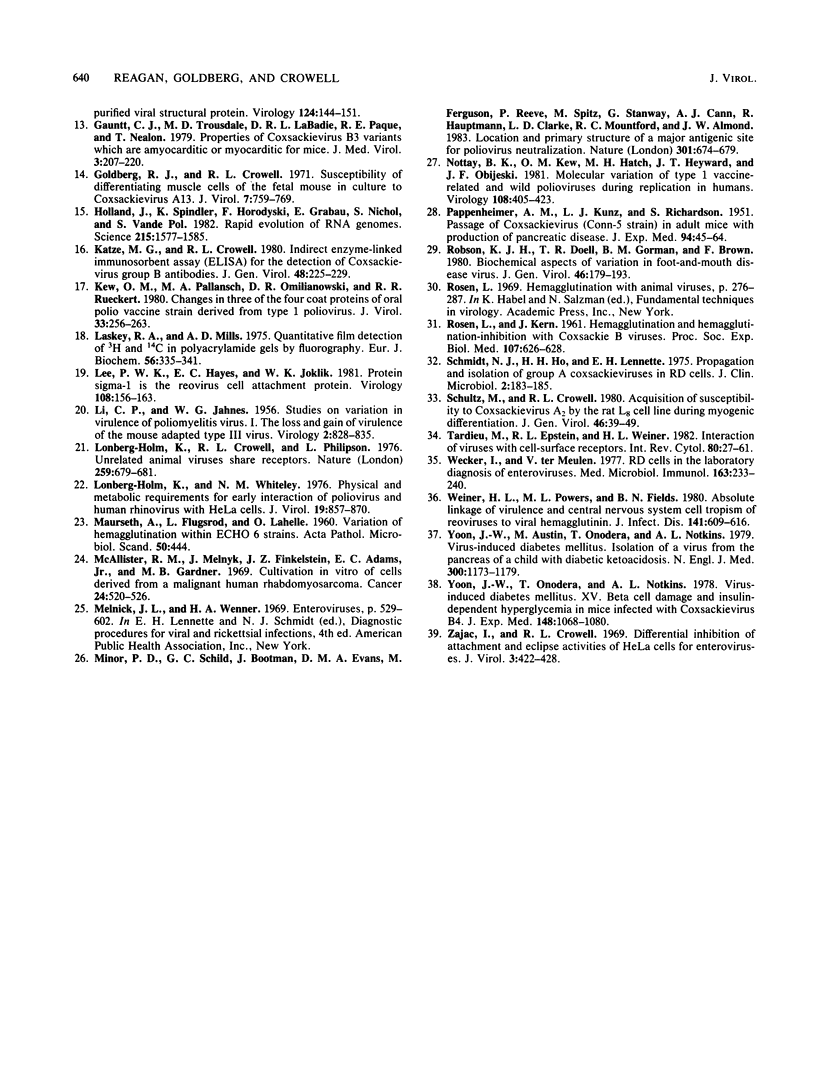
Images in this article
Selected References
These references are in PubMed. This may not be the complete list of references from this article.
- Beatrice S. T., Katze M. G., Zajac B. A., Crowell R. L. Induction of neutralizing antibodies by the coxsackievirus B3 virion polypeptide, VP2. Virology. 1980 Jul 30;104(2):426–438. doi: 10.1016/0042-6822(80)90345-1. [DOI] [PubMed] [Google Scholar]
- Bonner W. M., Laskey R. A. A film detection method for tritium-labelled proteins and nucleic acids in polyacrylamide gels. Eur J Biochem. 1974 Jul 1;46(1):83–88. doi: 10.1111/j.1432-1033.1974.tb03599.x. [DOI] [PubMed] [Google Scholar]
- CHOPPIN P. W., EGGERS H. J. Heterogeneity of Coxsackie B4 virus: two kinds of particles which differ in antibody sensitivity, growth rate, and plaque size. Virology. 1962 Nov;18:470–476. doi: 10.1016/0042-6822(62)90037-5. [DOI] [PubMed] [Google Scholar]
- CROWELL R. L., SYVERTON J. T. The mammalian cell-virus relationship. VI. Sustained infection of HeLa cells by Coxsackie B3 virus and effect on superinfection. J Exp Med. 1961 Feb 1;113:419–435. doi: 10.1084/jem.113.2.419. [DOI] [PMC free article] [PubMed] [Google Scholar]
- Cova L., Aymard M. Isolation and characterization of non-haemagglutinating echoviorus 11. J Gen Virol. 1980 Nov;51(Pt 1):219–222. doi: 10.1099/0022-1317-51-1-219. [DOI] [PubMed] [Google Scholar]
- Crowell R. L., Philipson L. Specific alterations of coxsackievirus B3 eluted from HeLa cells. J Virol. 1971 Oct;8(4):509–515. doi: 10.1128/jvi.8.4.509-515.1971. [DOI] [PMC free article] [PubMed] [Google Scholar]
- Crowell R. L. Specific cell-surface alteration by enteroviruses as reflected by viral-attachment interference. J Bacteriol. 1966 Jan;91(1):198–204. doi: 10.1128/jb.91.1.198-204.1966. [DOI] [PMC free article] [PubMed] [Google Scholar]
- Gauntt C. J., Trousdale M. D., LaBadie D. R., Paque R. E., Nealon T. Properties of coxsackievirus B3 variants which are amyocarditic or myocarditic for mice. J Med Virol. 1979;3(3):207–220. doi: 10.1002/jmv.1890030307. [DOI] [PubMed] [Google Scholar]
- Goldberg R. J., Crowell R. L. Susceptibility of differentiating muscle cells of the fetal mouse in culture to coxsackievirus A13. J Virol. 1971 Jun;7(6):759–769. doi: 10.1128/jvi.7.6.759-769.1971. [DOI] [PMC free article] [PubMed] [Google Scholar]
- Holland J., Spindler K., Horodyski F., Grabau E., Nichol S., VandePol S. Rapid evolution of RNA genomes. Science. 1982 Mar 26;215(4540):1577–1585. doi: 10.1126/science.7041255. [DOI] [PubMed] [Google Scholar]
- JAHNES W. G., LI C. P. Studies on variation in virulence of poliomyelitis virus. I. The loss and gain of virulence of the mouse-adapted type III virus. Virology. 1956 Dec;2(6):828–835. doi: 10.1016/0042-6822(56)90062-9. [DOI] [PubMed] [Google Scholar]
- Katze M. G., Crowell R. L. Indirect enzyme-linked immunosorbent assay (ELISA) for the detection of Coxsackievirus group B antibodies. J Gen Virol. 1980 May;48(1):225–229. doi: 10.1099/0022-1317-48-1-225. [DOI] [PubMed] [Google Scholar]
- Kew O. M., Pallansch M. A., Omilianowski D. R., Rueckert R. R. Changes in three of the four coat proteins of oral polio vaccine strain derived from type 1 poliovirus. J Virol. 1980 Jan;33(1):256–263. doi: 10.1128/jvi.33.1.256-263.1980. [DOI] [PMC free article] [PubMed] [Google Scholar]
- Laskey R. A., Mills A. D. Quantitative film detection of 3H and 14C in polyacrylamide gels by fluorography. Eur J Biochem. 1975 Aug 15;56(2):335–341. doi: 10.1111/j.1432-1033.1975.tb02238.x. [DOI] [PubMed] [Google Scholar]
- Lee P. W., Hayes E. C., Joklik W. K. Protein sigma 1 is the reovirus cell attachment protein. Virology. 1981 Jan 15;108(1):156–163. doi: 10.1016/0042-6822(81)90535-3. [DOI] [PubMed] [Google Scholar]
- Lonberg-Holm K., Crowell R. L., Philipson L. Unrelated animal viruses share receptors. Nature. 1976 Feb 26;259(5545):679–681. doi: 10.1038/259679a0. [DOI] [PubMed] [Google Scholar]
- Lonberg-Holm K., Whiteley N. M. Physical and metabolic requirements for early interaction of poliovirus and human rhinovirus with HeLa cells. J Virol. 1976 Sep;19(3):857–870. doi: 10.1128/jvi.19.3.857-870.1976. [DOI] [PMC free article] [PubMed] [Google Scholar]
- MAURSETH A., FLUGSRUD L., LAHELLE O. Variation of hemagglutination within ECHO 6 strains. Acta Pathol Microbiol Scand. 1960;50:444–444. doi: 10.1111/j.1699-0463.1960.tb01214.x. [DOI] [PubMed] [Google Scholar]
- McAllister R. M., Melnyk J., Finkelstein J. Z., Adams E. C., Jr, Gardner M. B. Cultivation in vitro of cells derived from a human rhabdomyosarcoma. Cancer. 1969 Sep;24(3):520–526. doi: 10.1002/1097-0142(196909)24:3<520::aid-cncr2820240313>3.0.co;2-m. [DOI] [PubMed] [Google Scholar]
- Minor P. D., Schild G. C., Bootman J., Evans D. M., Ferguson M., Reeve P., Spitz M., Stanway G., Cann A. J., Hauptmann R. Location and primary structure of a major antigenic site for poliovirus neutralization. Nature. 1983 Feb 24;301(5902):674–679. doi: 10.1038/301674a0. [DOI] [PubMed] [Google Scholar]
- Nottay B. K., Kew O. M., Hatch M. H., Heyward J. T., Obijeski J. F. Molecular variation of type 1 vaccine-related and wild polioviruses during replication in humans. Virology. 1981 Jan 30;108(2):405–423. doi: 10.1016/0042-6822(81)90448-7. [DOI] [PubMed] [Google Scholar]
- PAPPENHEIMER A. M., KUNZ L. J., RICHARDSON S. Passage of Coxsackie virus (Connecticut-5 strain) in adult mice with production of pancreatic disease. J Exp Med. 1951 Jul 1;94(1):45–64. doi: 10.1084/jem.94.1.45. [DOI] [PMC free article] [PubMed] [Google Scholar]
- ROSEN L., KERN J. Hemagglutination and hemagglutination-inhibition with Coxsackie B viruses. Proc Soc Exp Biol Med. 1961 Jul;107:626–628. doi: 10.3181/00379727-107-26708. [DOI] [PubMed] [Google Scholar]
- Robson K. J., Doel T. R., Gorman B. M., Brown F. Biochemical aspects of variation in foot-and-mouth disease virus. J Gen Virol. 1980 Jan;46(1):179–193. doi: 10.1099/0022-1317-46-1-179. [DOI] [PubMed] [Google Scholar]
- Schmidt N. J., Ho H. H., Lennette E. H. Propagation and isolation of group A coxsackieviruses in RD cells. J Clin Microbiol. 1975 Sep;2(3):183–185. doi: 10.1128/jcm.2.3.183-185.1975. [DOI] [PMC free article] [PubMed] [Google Scholar]
- Schultz M., Crowell R. L. Acquisition of susceptibility to coxsackievirus A2 by the rat L8 cell line during myogenic differentiation. J Gen Virol. 1980 Jan;46(1):39–49. doi: 10.1099/0022-1317-46-1-39. [DOI] [PubMed] [Google Scholar]
- Tardieu M., Epstein R. L., Weiner H. L. Interaction of viruses with cell surface receptors. Int Rev Cytol. 1982;80:27–61. doi: 10.1016/S0074-7696(08)60366-6. [DOI] [PMC free article] [PubMed] [Google Scholar]
- Wecker I., ter Meulen V. RD cells in the laboratory diagnosis of enteroviruses. Med Microbiol Immunol. 1977 Dec 27;163(4):233–240. doi: 10.1007/BF02125507. [DOI] [PubMed] [Google Scholar]
- Weiner H. L., Powers M. L., Fields B. N. Absolute linkage of virulence and central nervous system cell tropism of reoviruses to viral hemagglutinin. J Infect Dis. 1980 May;141(5):609–616. doi: 10.1093/infdis/141.5.609. [DOI] [PubMed] [Google Scholar]
- Yoon J. W., Austin M., Onodera T., Notkins A. L. Isolation of a virus from the pancreas of a child with diabetic ketoacidosis. N Engl J Med. 1979 May 24;300(21):1173–1179. doi: 10.1056/NEJM197905243002102. [DOI] [PubMed] [Google Scholar]
- Yoon J. W., Onodera T., Notkins A. L. Virus-induced diabetes mellitus. XV. Beta cell damage and insulin-dependent hyperglycemia in mice infected with coxsackie virus B4. J Exp Med. 1978 Oct 1;148(4):1068–1080. doi: 10.1084/jem.148.4.1068. [DOI] [PMC free article] [PubMed] [Google Scholar]
- Zajac I., Crowell R. L. Differential inhibition of attachment and eclipse activities of HeLa cells for enteroviruses. J Virol. 1969 Apr;3(4):422–428. doi: 10.1128/jvi.3.4.422-428.1969. [DOI] [PMC free article] [PubMed] [Google Scholar]




